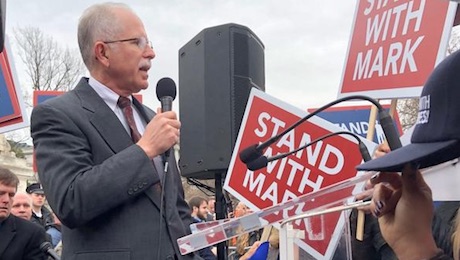This commentary is by Stan Greer, senior research associate for the National Institute for Labor Relations Research.
Powerful teacher union officials like Becky Pringle, president of the mammoth National Education Association (NEA), and Randi Weingarten, president of the nearly-as-large American Federation of Teachers (AFT/AFL-CIO), routinely try to deflect criticism of their outrageous actions by labeling it as criticism of “teachers.”
As convenient as it is for Pringle, Weingarten, and their cohorts to do so, it is for multiple reasons a fallacy to equate “teacher unions,” much less “teacher union bosses,” with teachers.

Mark Janus, the plaintiff in Janus vs. AFSCME, The U.S. Supreme Court in 2018 ruled that public sector workers cannot be forced to pay fees to unions that represent them in collective bargaining.
Just for starters, the NEA and AFT only became the political powerhouses they are today, with combined annual revenues in excess of $2 billion, after roughly 20 states, including high-population California, New York, Illinois, Pennsylvania, Ohio and Michigan, enacted laws authorizing union bosses to extract forced “agency” fees as a job condition from public educators who refused to join, or quit, their organizations.
Until Illinois civil servant Mark Janus and his attorneys, led by National Right to Work Legal Defense Foundation staff attorney William Messenger, successfully challenged government- sector forced-union-fee laws in a U.S. Supreme case decided in 2018, many teachers joined NEA or AFT affiliates only because they knew they would be fired if they didn’t bankroll them.
Even post-Janus, government school teachers in more than 30 states remain subject to state laws authorizing union officials to seek and obtain the power to force school employees, whether they are union members or not, to accept them as their “exclusive” (monopoly) spokespersons in dealings with their employer concerning pay, benefits, and work rules.
As then-AFL-CIO Associate General Counsel Thomas Harris acknowledged six decades ago, the simple fact that a union “will negotiate the contract which regulates the incidents of [a worker’s] industrial life” puts the worker “under powerful compulsion to join the union.”
Despite pro-union monopoly laws covering the vast majority of the nation’s K-12 teachers and many other K-12 employees giving them a strong incentive to stay in unions even if they don’t agree with them, vast numbers have quit government unions over the past decade and a half.
For example, from the 2008-2009 through the 2017-18 academic years, the number of actively employed, dues-paying NEA members fell by 258,000, or 9.0%. This steep decline occurred over a period when the nationwide total of government K-12 educational employees was rising.
Of course, before the Janus decision was published in late June 2018, union resignations by teachers and other school employees were, to a large extent, merely symbolic in the Big Labor-dominated states where the vast majority of unionized educators live and work. In the words of journalist Arno Rosenfeld, “while you were no longer a member, you still had to pay dues.”
But as soon as Janus came down, every school teacher, guidance counselor and nurse who had already quit the union, or refused to join in the first place, but was still being forced to fork over union dues or fees to remain employed was immediately freed to cut off all financial support for Big Labor. And a recent analysis by Pennsylvania’s Commonwealth Foundation found that in the years since Janus an additional 125,000 active members have dropped out of teacher unions that they don’t believe speak for them.
There are manifold good reasons why an educator might choose to dissociate from the NEA or the AFT union empire. For example, conscientious school employees have long opposed union work rules that shield teachers from “meaningful evaluations” and “require instructors to be laid off based on seniority instead of performance.” And just recently, teachers who harbor very reasonable doubts about the health benefits of wearing a mask at school all day, every day, and have grain concerns about the cost, have been resigning from unions that push for mandatory masking.
The bottom line is, despite having benefited enormously for well over half a century from state labor laws that operate like cattle prods to corral public educators into unions whether they want to join or not, members of the NEA and AFT union conglomerates now constitute only a minority of America’s primary, middle, and secondary school teachers. To conflate criticism of top union bosses like Becky Pringle and Randi Weingarten with criticism of “teachers” is simply ridiculous.



The problem isn’t the union, it’s the monopoly in which it operates. Yes, the teacher’s unions have immense power. But it’s the fact that they operate in, and control, the monopoly that gives them that power. Eliminate the K-12 public education monopoly with school choice vouchers and the unions will be no different than any other collective bargaining organization.